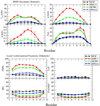Secondary structure bias in generalized Born solvent models: comparison of conformational ensembles and free energy of solvent polarization from explicit and implicit solvation
- PMID: 17256983
- PMCID: PMC4810457
- DOI: 10.1021/jp066831u
Secondary structure bias in generalized Born solvent models: comparison of conformational ensembles and free energy of solvent polarization from explicit and implicit solvation
Abstract
The effects of the use of three generalized Born (GB) implicit solvent models on the thermodynamics of a simple polyalanine peptide are studied via comparing several hundred nanoseconds of well-converged replica exchange molecular dynamics (REMD) simulations using explicit TIP3P solvent to REMD simulations with the GB solvent models. It is found that when compared to REMD simulations using TIP3P the GB REMD simulations contain significant differences in secondary structure populations, most notably an overabundance of alpha-helical secondary structure. This discrepancy is explored via comparison of the differences in the electrostatic component of the free energy of solvation (DeltaDeltaG(pol)) between TIP3P (via thermodynamic Integration calculations), the GB models, and an implicit solvent model based on the Poisson equation (PE). The electrostatic components of the solvation free energies are calculated using each solvent model for four representative conformations of Ala10. Since the PE model is found to have the best performance with respect to reproducing TIP3P DeltaDeltaG(pol) values, effective Born radii from the GB models are compared to effective Born radii calculated with PE (so-called perfect radii), and significant and numerous deviations in GB radii from perfect radii are found in all GB models. The effect of these deviations on the solvation free energy is discussed, and it is shown that even when perfect radii are used the agreement of GB with TIP3P DeltaDeltaG(pol) values does not improve. This suggests a limit to the optimization of the effective Born radius calculation and that future efforts to improve the accuracy of GB models must extend beyond such optimizations.
Figures



Similar articles
-
Protein-Ligand Electrostatic Binding Free Energies from Explicit and Implicit Solvation.J Chem Theory Comput. 2015 Sep 8;11(9):4450-9. doi: 10.1021/acs.jctc.5b00483. Epub 2015 Aug 21. J Chem Theory Comput. 2015. PMID: 26575935 Free PMC article.
-
Accuracy comparison of several common implicit solvent models and their implementations in the context of protein-ligand binding.J Mol Graph Model. 2017 Mar;72:70-80. doi: 10.1016/j.jmgm.2016.12.011. Epub 2016 Dec 21. J Mol Graph Model. 2017. PMID: 28064081 Free PMC article.
-
Generalized Born and Explicit Solvent Models for Free Energy Calculations in Organic Solvents: Cyclodextrin Dimerization.J Chem Theory Comput. 2015 Nov 10;11(11):5103-13. doi: 10.1021/acs.jctc.5b00620. Epub 2015 Oct 8. J Chem Theory Comput. 2015. PMID: 26574308
-
Generalized Born Implicit Solvent Models for Biomolecules.Annu Rev Biophys. 2019 May 6;48:275-296. doi: 10.1146/annurev-biophys-052118-115325. Epub 2019 Mar 11. Annu Rev Biophys. 2019. PMID: 30857399 Free PMC article. Review.
-
Recent advances in implicit solvent-based methods for biomolecular simulations.Curr Opin Struct Biol. 2008 Apr;18(2):140-8. doi: 10.1016/j.sbi.2008.01.003. Epub 2008 Mar 4. Curr Opin Struct Biol. 2008. PMID: 18304802 Free PMC article. Review.
Cited by
-
Transferable Implicit Solvation via Contrastive Learning of Graph Neural Networks.ACS Cent Sci. 2023 Nov 16;9(12):2286-2297. doi: 10.1021/acscentsci.3c01160. eCollection 2023 Dec 27. ACS Cent Sci. 2023. PMID: 38161379 Free PMC article.
-
Improved Generalized Born Solvent Model Parameters for Protein Simulations.J Chem Theory Comput. 2013 Apr 9;9(4):2020-2034. doi: 10.1021/ct3010485. J Chem Theory Comput. 2013. PMID: 25788871 Free PMC article.
-
MELD × MD Folds Nonthreadables, Giving Native Structures and Populations.J Chem Theory Comput. 2018 Dec 11;14(12):6734-6740. doi: 10.1021/acs.jctc.8b00886. Epub 2018 Nov 21. J Chem Theory Comput. 2018. PMID: 30407805 Free PMC article.
-
NMR-assisted protein structure prediction with MELDxMD.Proteins. 2019 Dec;87(12):1333-1340. doi: 10.1002/prot.25788. Epub 2019 Aug 8. Proteins. 2019. PMID: 31350773 Free PMC article.
-
Application of Ligand- and Structure-Based Prediction Models for the Design of Alkylhydrazide-Based HDAC3 Inhibitors as Novel Anti-Cancer Compounds.Pharmaceuticals (Basel). 2023 Jul 6;16(7):968. doi: 10.3390/ph16070968. Pharmaceuticals (Basel). 2023. PMID: 37513880 Free PMC article.
References
-
- Feig M, Brooks CL. Current Opinion in Structural Biology. 2004;14:217. - PubMed
-
- Levy RM, Gallicchio E. Annual Review of Physical Chemistry. 1998;49:531. - PubMed
-
- Zagrovic B, Pande V. Journal of Computational Chemistry. 2003;24:1432. - PubMed
-
- Roux B, Simonson T. Biophysical Chemistry. 1999;78:1. - PubMed
-
- Gilson MK, Davis ME, Luty BA, Mccammon JA. Journal of Physical Chemistry. 1993;97:3591.
Publication types
MeSH terms
Substances
Grants and funding
LinkOut - more resources
Full Text Sources

